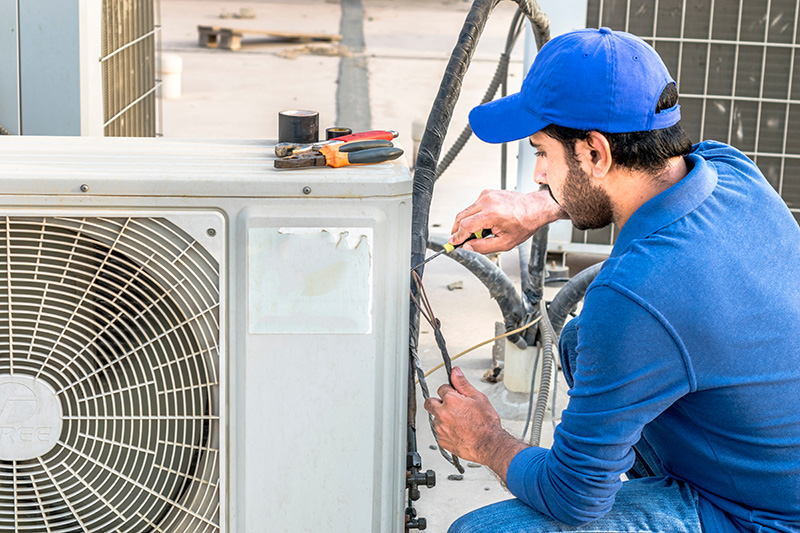Vibrations in the compressor:
The compressor is the central component of an air conditioning system and is responsible for pumping refrigerant through the system to remove and transfer heat. The humming or vibrating sound coming from an air conditioner is often the result of vibrations from the compressor. These vibrations are caused by the motor along with other moving parts inside the compressor.
If you want to keep vibrations to a minimum, it’s essential that the compressor is well-balanced and this can be done by proper aircon servicing Singapore. But eventually, wear and tear might cause imbalances that contribute to the obvious shaking of the device. Lubricating moving parts and inspecting for worn-out components as part of routine maintenance can help reduce the severity of this problem.
Improper installation:
Another key factor contributing to AC vibrations is sloppy installation. Incorrect installation might lead to the air conditioner not being level with the ceiling or properly secured to the floor. Vibrations may occur during operation due to this lack of stability. A properly placed air conditioner will be level, and its parts will be secured tightly. The entire system can vibrate and make a buzzing or shaking noise if the device is positioned on an unsteady surface or if the mounting brackets are not tight. This may be avoided by having a professional install your system and checking it regularly to make sure it is stable.
Age and wear:
Air conditioners age and wear out just like any other mechanical device. Deterioration of motor bearings and other parts with age might enhance vibrations. In addition, the effectiveness of vibration-dampening isolation pads can degrade over time. The AC unit’s life can be prolonged and vibrations reduced by replacing worn-out parts and checking the quality of the isolation pads.
Loose components:
The components of an air conditioner shake constantly as it runs. This can gradually loosen various parts over time. The unit’s vibrations can be increased by loose screws, nuts, or fasteners, resulting in a distracting hum or buzz. To avoid excessive vibrations, it is important to do routine maintenance, such as tightening any loose components. This is a simple task that homeowners can either do themselves or have a technician do as part of routine AC maintenance.
Resonance and ductwork:
Ductwork airflow can generate resonance, which in turn increases system-wide vibrations. If the ducts aren’t properly insulated or if there are any loose pieces, this effect will be magnified. It is essential to check the ductwork for any indications of disconnection, damage, or insufficient insulation. Solving these problems will result in less vibration being transmitted and a quieter running air conditioner.
Problems with the fans:
The fans of an air conditioner are responsible for removing the heat generated by the condenser coils. Vibrations can occur if there is an imbalance in the system, such as when debris gets caught in the fan or the fan blades aren’t aligned properly. It is crucial to inspect the fan blades and make sure they are clean and undamaged. Sometimes the problem can be fixed by giving the fan a good cleaning, but other times it may require the assistance of a professional to realign the blades or replace the broken parts.
Refrigerant issues:
Low refrigerant levels or problems with the refrigerant flow are another possible cause of AC unit vibrations. Overheating of the compressor may result from insufficient refrigerant levels, causing higher vibrations. One of the most important aspects of keeping your air conditioner in good working order is keeping the refrigerant levels at the right levels. Excessive vibrations and consequent damage to the compressor can be avoided if problems with the refrigerant cycle and leaks are resolved as soon as they are discovered.
Electrical problems:
Vibrations in an air conditioner might also be caused by electrical problems. Fluctuations in voltage or current might impair the performance of the compressor motor, resulting to unpredictable vibrations. This becomes more obvious when there are problems with the unit’s wiring or the power supply. It is crucial to guarantee a constant and well-grounded electrical supply. Consult a licensed electrician to investigate the source of the vibrations and fix the wiring if the problem persists electrically.
Environmental factors:
Vibrations in an air conditioner may have external causes, such as weather or construction nearby. Increased vibrations can occur, for instance, if the outdoor unit is located on an uneven surface or is surrounded by items that prevent adequate ventilation. Checking the area around the outside unit on a regular basis, clearing away garbage, and making sure the surface is level can all help reduce vibrations from outside sources. Ventilating the space properly can also help the unit run more smoothly and with fewer vibrations.
Undersized or oversized unit:
Selecting the right-sized air conditioner for your room is vital. A unit that is too small for the space it is supposed to cool may force its parts to work constantly, increasing their noise and vibration output. On the other side, if the unit is too large, it may start and stop too often, causing vibrations and excessive wear on the system. Consulting with HVAC professionals to determine the optimum size for your living area and replacing or changing the unit accordingly will assist in eliminating vibrations and boosting overall system performance.
Problems with the evaporator coil:
The evaporator coil is a critical component of the air conditioner’s indoor unit. Debris and grime on the coil reduce its heat exchange efficiency, which in turn causes more vibrations. The evaporator coil needs to be cleaned and serviced regularly to avoid dirt build-up. This not only aids in preventing vibrations but also keeps cooling performance at its peak. If the coil is highly corroded or broken, it may be necessary to have a professional look at it and possibly replace it.

